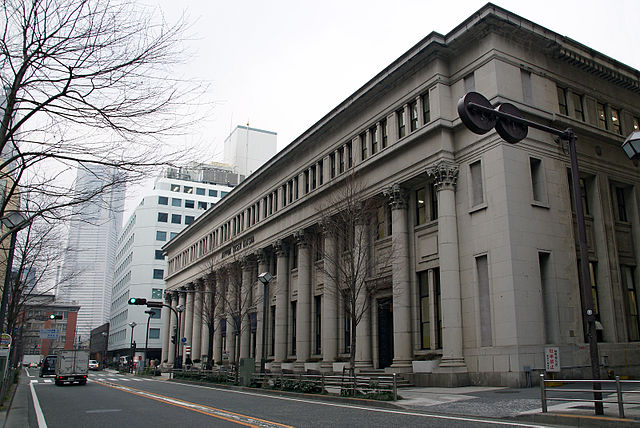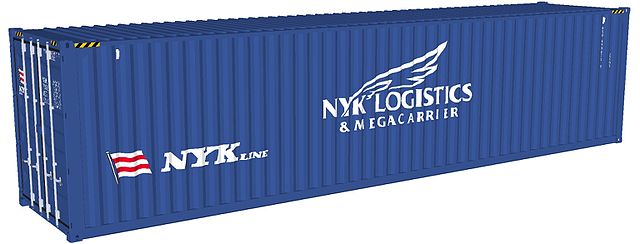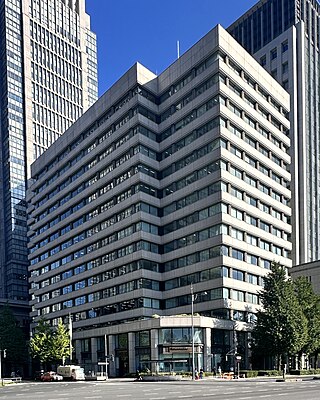Nippon Yusen
Japanese shipping line From Wikipedia, the free encyclopedia
The Nippon Yusen Kabushiki Kaisha (日本郵船株式会社, Nippon Yūsen kabushiki kaisha, lit. 'Japan Mail Ship Company'), also known as NYK Line, is a Japanese shipping company. The company headquarters are located in Chiyoda, Tokyo, Japan. It operates a fleet of over 800 ships, which includes container ships, tankers, bulk and woodchip carriers, roll-on/roll-off car carriers, reefer vessels, LNG carriers, and cruise ships. It is a member of the Ocean Network Express[2] and Mitsubishi Group.
 | |
 Headquarters in Marunouchi, Chiyoda, Tokyo | |
Native name | 日本郵船株式会社 |
|---|---|
| Company type | Public |
| TYO: 9101 Nikkei 225 Component | |
| Industry | Transportation |
| Founded | September 29, 1885 |
| Headquarters | Marunouchi, Chiyoda, Tokyo, Japan |
Key people | Hitoshi Nagasawa (chairman, Director) Takaya Soga (president)[1] |
| Products |
|
| Revenue | JP¥ 1,829 billion (US$ 16.5 billion) — FY 2019 |
| JP¥ 60.3 billion (US$ 543.4 million) — FY 2019 | |
Number of employees | 35,711 (as of March 31, 2019) |
| Website | nyk.com |
| Footnotes / references [2][3][4][5] | |


History
Summarize
Perspective
1870-1900
The company traces its history back to the Tsukumo Shokai shipping company founded by the Tosa clan in 1870. In 1875, as the renamed Mitsubishi Shokai, the company inaugurated Japan's first passenger liner service, with a route from Yokohama to Shanghai; in that same year, the company name was changed to Mitsubishi Mail Steamship Company. In 1885, a merger with Kyodo Unyu Kaisha (founded 1882) led to the adoption of the company's present name.[6]
The merged company had a fleet of 58 steamships and expanded its operations rapidly, first to other Asian ports and then worldwide, with a line service to Seattle established in 1896[7] and to London in 1899.[6]
The company's Katori Maru was used by Chinese Muslims to travel to Singapore on their way to Makkah for the Hajj in 1925. From there, the company had the pilgrims travel on board other Japanese steamships to Suez and then to Makkah. The company promised to take responsibility for all the necessary formalities and helped contact other local transportation agencies that could take the pilgrims to Makkah. Chinese pilgrims were promised a 20% discount for their tickets. A third-class ticket that sold for £5/10/0 would be £4/8/0, while a second-class ticket sold for £14/0/0 would be sold for £11/5/0.[8]
1900-1945
The majority of Japanese merchant ships, tankers, and liners sailed under the NYK banner in this period. Regular services linked Kobe and Yokohama with South America, Batavia, Melbourne, and Cape Town, with frequent crossings to San Francisco and Seattle.[citation needed] Other routes connected local Chinese cabotage vessels on the Chinese coasts and upper Yangtze River.[citation needed]
Ocean routes went east from Japan to Vancouver (Canada) or Seattle.[citation needed] Another way was to stop in Hawaii, which continued to San Francisco and the Panama Canal.[citation needed] The next commercial routes were south from Japan, across the East China Sea.[citation needed] These went to Southeast Asia, the China coasts, and towards India and the Indian Ocean, to Europe or Batavia (Dutch Indies), or Australia and New Zealand.[citation needed] The fastest services took 10 days from Yokohama to Seattle, and one month to Europe.[citation needed]
Local sea routes connected 78 home seaports (38 open to foreign trade). Yokohama, Kobe, and Osaka had the greatest importance for trading with Japan. These ports had the third, fourth, and eighth place in net tonnage registered in the world.[citation needed] Coal passed from Moji to Osaka and Yokohama.[citation needed] Karafuto timber represented a third part of local trade. Soybean products from Dairen and Ryojun arrived at Yokohama.[citation needed] The sugarcane of the South Seas Mandate and Formosa, cotton, salt, and minerals represented other important parts of these transport transactions.[citation needed] In 1926, Toyo Kisen Line (TKK), with its fleet of nine ships, merged with NYK. The current funnel livery was introduced in 1929.[citation needed] The company also ran services connecting metropolitan Japan to its exterior provinces (Chosen, Karafuto, Kwantung, Formosa and South Mandate) of the Empire.[citation needed]
From 1924, all new cargo ships for NYK were motor ships.[9] NYK introduced its first passenger motor ships in 1929, but continued to buy a mixture of steam and motor passenger ships until 1939.[10]
In World War II, the NYK Line provided military transport and hospital ships for the Imperial Japanese Army and Navy. Many vessels were sunk by the Allied navies, and installations and ports were attacked from the air. Only 37 NYK ships survived the war. The company lost 185 ships in support of military operations in the Pacific.[11] Before the war, NYK had 36 passenger ships;[10] by the time of Japan's surrender only one, the motor ship Hikawa Maru, survived.[12]
NYK's surviving vessels and equipment were confiscated by the Allied authorities as reparations, or taken by recently liberated Asian states in 1945-46. Shipping Control Authority for the Japanese Merchant Marine requisitioned Hikawa Maru as a transport ship to repatriate Japanese soldiers and civilians from territories that had been liberated from Japanese occupation.[12]
Fleet until 1945
The NYK tonnage expanded in bursts, responding to changes economic conditions and perceived changes in the market for passenger liner travel. The evolution of the fleet mirrors some of those developments. In the following lists, the dates of maiden voyages are indicated with each ship's name.[13]
Amongst the many ships in the early NYK fleet, some names comprise serial categories.[14] Some ships were named after Shinto shrines, and others were named after ancient provinces of Japan, cities of Japan, mountains of Japan or islands of Japan. Some ships had explicitly non-Japanese names, such as ships named after cities.
|
Shinto shrines |
Provinces[27][28] |
Mountains |
Cities |
Miscellaneous
|
Fleet in post-war era
The modern NYK tonnage encompasses a variety of ship names.[14] Some names form series, as in those ships named after flowers, stars, star constellations, and provinces of pre-Meiji Japan.
|
Flowers |
Stars |
Constellations |
Provinces |
Miscellaneous |
1950-present

By the mid-1950s NYK ships were again seen around the world.
As the demand for passenger ships dwindled in the 1960s, NYK expanded its cargo operation, running Japan's first container ship Hakone Maru on a route to California in 1968 and soon establishing container ship routes to many other ports. NYK became a partner in Nippon Cargo Airlines in 1978,
1985
Following the enactment of the U.S. Shipping Act of 1984, NYK shifted its focus towards mass intermodal transportation, including: (1) enlarged container ships in the trade, (2) NYK owned/operated container terminals at the U.S. West Coast gateways, and (3) participation in US inland transportation by introducing the operation of mile-long Double Stack Trains (two-tier container freight train service across the U.S., in collaboration with U.S. railway companies)."[64]
In May 1988
NYK Line decided to enter the world-wide luxury cruise ship market and established Crystal Cruises Inc. in Los Angeles.[64]
In July 1990
The first post-war cruise passenger ship Crystal Harmony has been completed (Mitsubishi Heavy Industries Nagasaki) and she marked the beginning of services with Crystal Cruises. (Los Angeles to Alaska and returned to San Francisco)[64]
In May 1995
The sister ship of Crystal Harmony, Crystal Symphony (built at Finland: Kvaerner Masa), commenced operation in Mediterranean cruises.[64]
In July 2004
The third ship of Crystal Cruises, Crystal Serenity (France: Chantiers de l'Atlantique), commenced operation in Europe.[64]
In Jan 2006
Crystal Harmony was sold from Crystal Cruises to NYK Cruises and began operation as Asuka II.[64]
March 2015
Crystal Cruises was sold to Genting Hong Kong.[64]
In May 2021
NYK Line became the first Japanese shipping firm to join the Sustainable Shipping Initiative's Ship Recycling Transparency Initiative, which incorporates the Hong Kong International Convention for the Safe and Environmentally Sound Recycling of Ships.[65]

On 19 November 2023, the NYK operated vessel Galaxy Leader, while sailing in Red Sea en route to India, was hijacked by the Iranian backed Houthi on the grounds it was an Israeli owned vessel. In May 2024 the owners asked the Houthis to release the crew.[66]
Merger of container operations
On Monday, 31 October 2016, Kawasaki Kisen Kaisha, Mitsui OSK Lines and Nippon Yusen Kaisha agreed to merge their container shipping business by establishing a completely new joint venture company. The integration included their overseas terminal activities. The joint venture company operates under the name "Ocean Network Express" (ONE), with the company headquarters in Japan (Tokyo), a global business operations headquarters in Singapore and regional headquarters in United Kingdom (London), United States (Richmond, VA), Hong Kong, and Brazil (São Paulo).[67] The new company started its operations on 1 April 2018.[68]
Container vessels fleet

| Ship class | Built | Capacity (TEU) | Ships in class | Notes |
|---|---|---|---|---|
| NYK Vega-class | 2006–2007 | 9,012 | 4 | Operated by Ocean Network Express |
| NYK Oceanus-class | 2007–2008 | 8,628–9,040 | 4 | Operated by Ocean Network Express |
| NYK Adonis-class | 2010–2011 | 9,592 | 3 | Operated by Ocean Network Express |
| NYK Bird-class | 2016–2019 | 14,000 | 15 | Operated by Ocean Network Express |
Roll-on/roll-off division

NYK is also the world's largest roll-on/roll-off ocean carrier. NYK's RORO fleet has a 660,000 car capacity which represents just over 17% of the global car transportation fleet capacity. Over 123 vessels are deployed worldwide transporting cars[69] manufactured in Japan, US, EU towards Asia, Middle East, North & South America,[70] Australia, Africa and Europe. In addition to brand new cars, High and Heavy cargo (such as excavators, mobile cranes, new and used trucks and buses, trailers, Mafi roll trailers) and break bulk static pieces are carried all over the globe by NYK.



See also
- Hikawa Maru-class ocean liner
- New Carissa
- Terukuni Maru-class ocean liner
- John Wilson
References
Further reading
External links
Wikiwand - on
Seamless Wikipedia browsing. On steroids.
